How to monitor and treat the most troublesome crop pests
With the number and efficacy of chemical products for pest control in decline, it is more important than ever to know what is going on in your fields and to treat at the right time.
Critically, this means not just knowing when to act and defend your crops, but when to leave the chemical can in the shed and not waste time and money on a pass with the sprayer that will contribute to the increasing resistance problems while doing nothing to improve yields.
Breaking the life cycle of the pea moth, for example, requires hitting the caterpillar as it hatches, which means knowing when egg laying began, and monitoring subsequent temperature data. Attempting to control it at any other time will have little or no effect.
See also: Video: How to properly set up a crop sprayer
With the help of agronomists and experts from Frontier, the Processors and Growers Research Organisation and Fera Science, we have identified which pests can cause the biggest problem and how to monitor them in your crops.
- Bruchid beetle
- Pea aphid/black bean aphid
- Pea moth
- Pea and bean weevil
- Grain aphid
- Peach potato aphid
- Cabbage stem flea beetle
- Orange wheat blossom midge
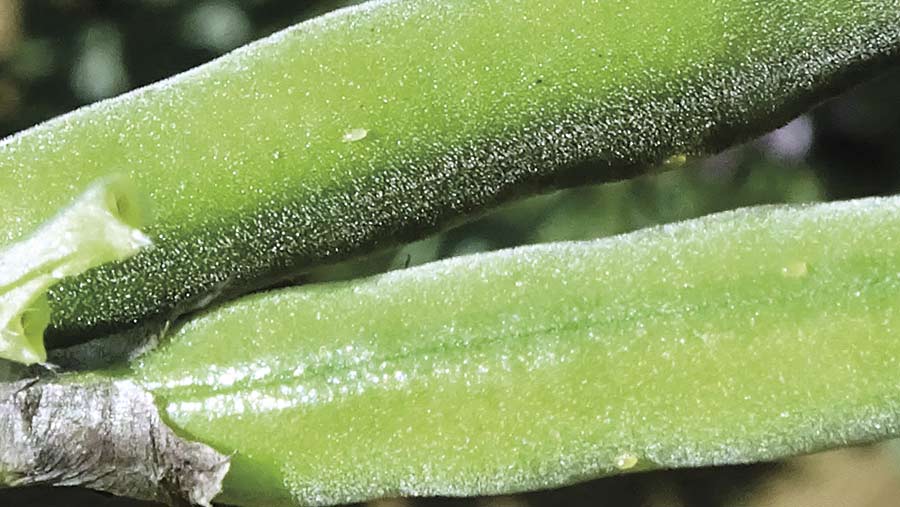
Bruchid eggs on pods © PGRO
Bruchid beetle
Destroys the quality of beans, making them unfit for human consumption.
Danger time: The beetle emerges in the spring once temperatures reach 17-18C. Growers need to check crops during flowering and from the first-pod stage at the beginning to middle of June.
Highest-risk crops: Winter-planted beans near large hedgerows and standing trees. The beetle needs to feed in bean flowers to become reproductive and winter crops will often be the first ones with pods available.
The biggest populations are found in the south-eastern counties as far north as Lincolnshire and all bean crops in these regions are at risk from damage.
Detection method: No traps are available commercially, but growers willing to take part in the monitoring network can obtain them from the PGRO, as well as read pest updates online.
For information on traps, contact PGRO prinicipal technical officer Becky Ward by email on becky@pgro.org or by calling 01780 781 351.
In the absence of traps, crops can be checked from the beginning of flowering (in the middle of a warm day) by tapping a flower into the hand – beetles will fall out. Pods should be examined for eggs once they stick out from flowers.
Syngenta offers the forecasting system BruchidCast that, based on regional temperature data, warns growers when infestations are likely. Sign up on the Syngenta website.
Treatment threshold: Where beetles are known to be present, crops should be sprayed when the temperature has reached 20C for two consecutive days and first pods on bottom trusses are present.
Treatment: A limited selection of pyrethroids have approval for application at flowering only. Check labels and consult your agronomist if in any doubt.
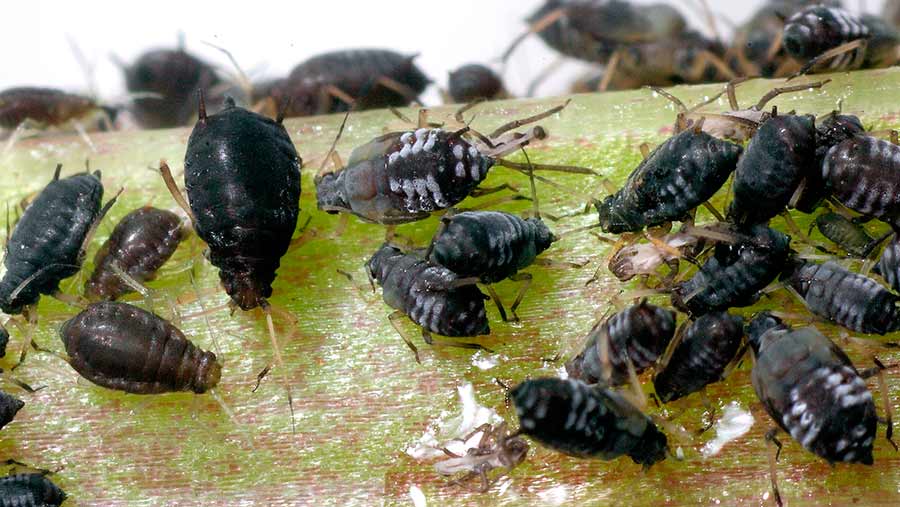
Black bean aphids on bean stem © Blackthorn-Arable
Pea aphid/black bean aphid
Transmits viruses into crops and viruses transmitted before flowering do the most damage.
Highest-risk crops: Pea aphids affect peas and beans. Black bean aphids affect beans and sugar beet.
Danger time: Warm humid weather between 18-23C – usually in May.
Detection method: Crop inspections and keeping up to date with the aphid alert system managed between Rothamsted Research, Science and Advice for Scottish Agriculture (SASA), Fera Science and the AHDB.
You can sign up for aphid alert bulletins by email on the AHDB website or read the bulletins online on the PGRO website.
Treatment threshold: Thresholds are as follows:
- Pea aphid in combinable peas – 20% of plants affected.
- Pea aphid in vining peas – 15% of plants affected.
- Black bean aphid in beans – 10% of plants affected.
Treatment: Control in peas can be achieved by using primicarb or thiacloprid products, and in beans by using primicarb products. Partial control may be achieved using pyrethroids. However, some approvals for primicarb products are expiring this year.
All primicarb products are limited to a single application per season and cannot be applied until growth stage 51 (first flowering).
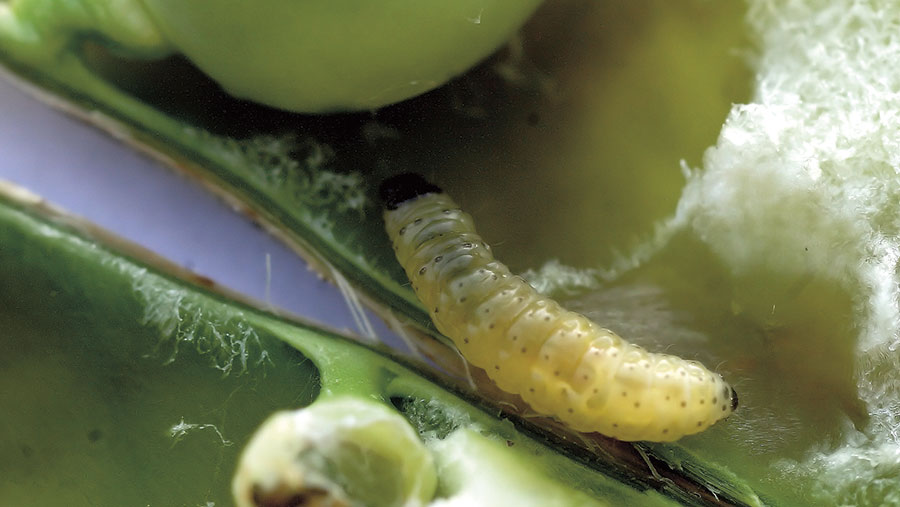
Larvae of pea moth in pod © Blackthorn Arable
Pea moth
Caterpillars of the moth feed inside the pod, destroying peas.
Danger time: The moth overwinters in cocoons in the soil and emerges towards the end of May to lay eggs on the plant, with caterpillars hatching eight to 20 days later. Control is based on killing the caterpillars to interrupt the life cycle.
Highest-risk crops: Most pea crops are vulnerable. This is one of the most common and damaging pea pests in the country.
Detection method: A combination of monitoring with commercially available pheromone traps and temperature data. Set pheromone traps up in mid-May. There are two traps per system, with each system covering up to 50ha. Traps should be monitored three times a week.
Treatment threshold: 10 moths in either trap on two consecutive visits. The hatching date of caterpillars can be accurately predicted using temperature data and the calculator provided with traps.
Alternatively, once the threshold in the field is passed, growers can visit the pea moth page on the PGRO website and use the online tool for a forecast of when to spray, as well as read technical updates.
Treatment: Only treat crops that are at first pod set or that have flowered. Several pyrethroid products are available and have no reported resistance issues.
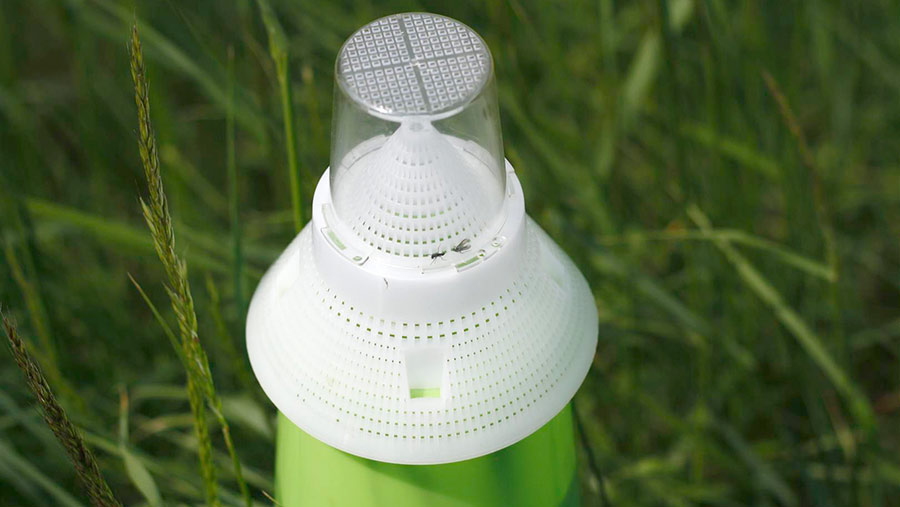
Pea and bean weevil trap © PGRO
Pea and bean weevil
Larvae feeds on plant roots, damaging them and reducing yield.
Danger time: Early spring once temperatures are above 12C.
Highest-risk crops: The weevil overwinters in hedgerows and field margins, so crops in smaller fields may be vulnerable, with the south-east of England having the biggest pest populations.
Early-drilled spring crops and those that are already stressed are also at higher risk, as slower growth means slower recovery.
Detection method: Pheromone traps are commercially available. Physical damage from adults will take the form of U-shaped notching around the edges of leaves. When eggs hatch, larvae will feed on root nodules. Preventing egg laying is crucial.
Treatment threshold: Traps should be checked three times a week from mid-February. On any single recording day an average of 30 weevils per trap will justify spraying crops that have recently emerged and those that emerge within 10 days.
Treatment: Only pyrethroids are available and partial resistance has been detected. No more than two applications are recommended in a season, at no less than 10-14 days apart.
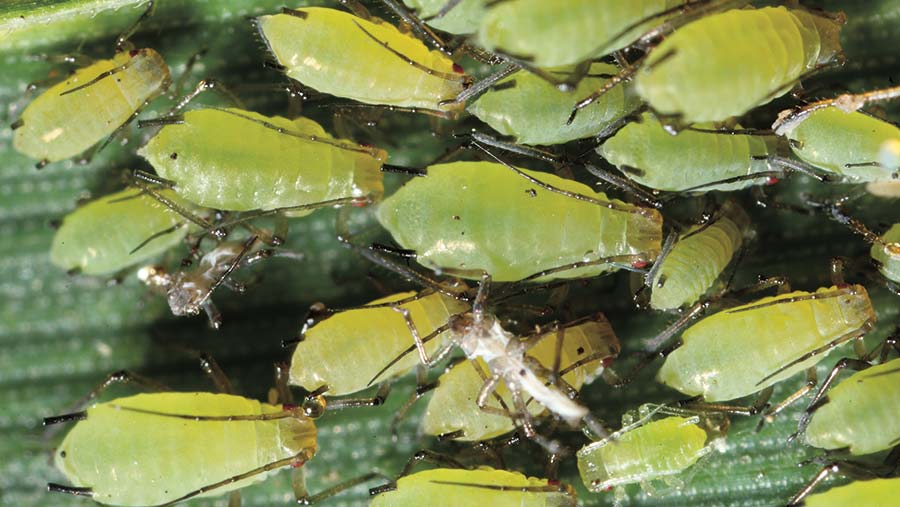
Grain aphid colony © Blackthorn Arable
Grain aphid
Transmits barley yellow dwarf virus, which can reduce yields in barley and wheat. Also causes physical damage to the ear until the end of grain fill.
Danger time: In wheat: for the virus – until growth stage 31 – with spring time the highest risk as seed treatments and follow-ups wear off. On the ear until growth stage 73. Barley is reliant on foliar sprays.
Highest-risk crops: At risk of virus transmission – newly emerged winter and spring cereal crops, particularly near grass. At risk of feeding damage – crops that are at the early grain filling stage during a period of dry, settled weather.
Detection method: Often monitored chiefly by agronomists, but trapping kits are available from Fera Science. Monitor from two weeks before emergence to assess risk.
Trap contents can be sent once or twice a week during high-risk times until the aphid is detected. The trap costs £30 with analysis at £32 per sample. Use one trap per field. Traps should be placed on the side of the field from which the prevailing wind blows.
There is more information about Fera Science’s insect monitoring service on its website. Sign up for aphid alert bulletins to be delivered via email on the AHDB website or read them on the PGRO website.
These bring together insect monitoring information from sources including Fera Science’s yellow water traps (funded by the AHDB) and Rothamsted Research’s high-level suction traps.
Treatment threshold: Before growth stage 61, 50% of tillers infected. From growth stage 61 until two weeks before the end of grain fill – around growth stage 73 – 66% of tillers infested.
Treatment: Seed treatment (clothianidin) available for wheat and barley. Only pyrethroids available for foliar applications in either crop. Some resistance has been detected.
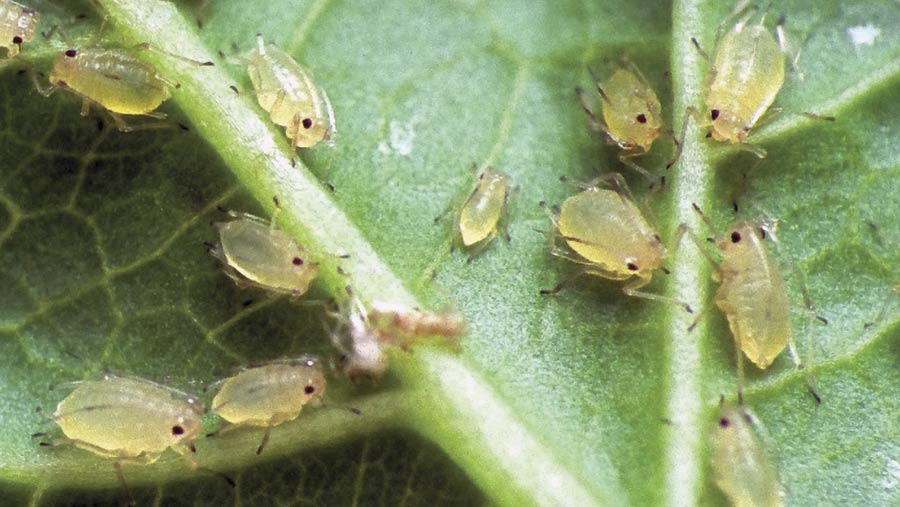
Peach potato aphid © Blackthorn Arable
Peach potato aphid
Transmits turnip yellows virus into oilseed rape.
Danger time: From the beginning of September until the weather turns cold.
Highest-risk crops: Freshly planted winter crops.
Detection method: Monitoring with commercially available yellow water traps should begin two weeks before emergence to assess risk.
Yellow water trap contents can be sent to Fera once or twice a week during high-risk times until the aphid is detected. The trap costs £30 with analysis at £32 per sample. Use one trap per field. Traps should be placed on the side of the field from which the prevailing wind blows.
There is more information about Fera Science’s insect monitoring service on its website. Sign up for aphid alert bulletins to be delivered via email on the AHDB website or read them on the PGRO website.
These bring together insect monitoring information from sources including Fera Science’s yellow water traps (funded by the AHDB) and Rothamsted Research’s high-level suction traps.
Treatment threshold: Treat once the aphids are detected in the traps or the crop, except in crops with resistance characteristics.
Treatment: Widespread resistance to primicarb and pyrethroids means there is increasing reliance on thiacloprid and pymetrozine products.
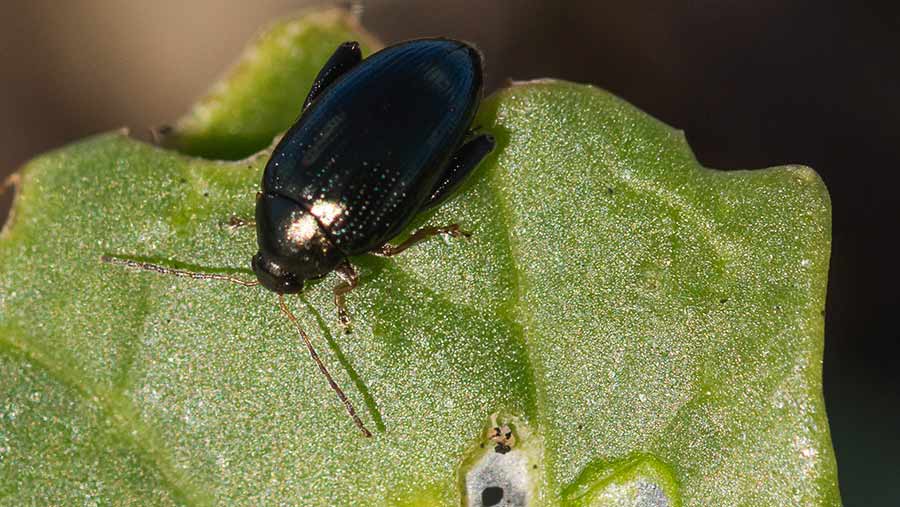
Cabbage stem flea beetle on OSR leaf © Blackthorn Arable
Cabbage stem flea beetle
Leaf grazing damage by adults and interior damage by the larvae.
Danger time: Adults – from the beginning of September until the weather turns cold. A large egg-laying population will cause further crop damage when the larvae hatch in the autumn and feed inside the plants through the winter.
Highest-risk crops: Freshly planted winter oilseed rape crops.
Detection method: Crop inspection. Beetles will be visible, but they can also be detected by their signature damage – shot holing – which are spherical holes through the leaf.
Trapping with yellow water traps from early September until the adult beetles stop flying (usually the end of October except in more recent warm years).
Yellow water trap contents can be sent to Fera Science once or twice a week during high risk times until the pest is detected. The trap costs £30 and analysis is £38 a sample. Use four traps per field and instructions on trap placement will be provided.
Treatment threshold: Adult beetles – at the cotyledon stage, treatment should be at the first sign of damage.
If the plant has up to two leaves, then 25% of the leaf area missing will justify treatment. At the three- to four-leaf stage, 50% of the leaf area should be missing before spraying, as bigger plants can recover more easily.
If trapping adults, the number of adults will indicate the number of larvae in the plants. At 96 adults a trap from about the beginning of September until the end of October, five larvae per plant should be expected. That is the recommended treatment threshold.
Treatment: Pyrethroid products. Significant resistance to pyrethroid products has been recorded, particularly in the South East.
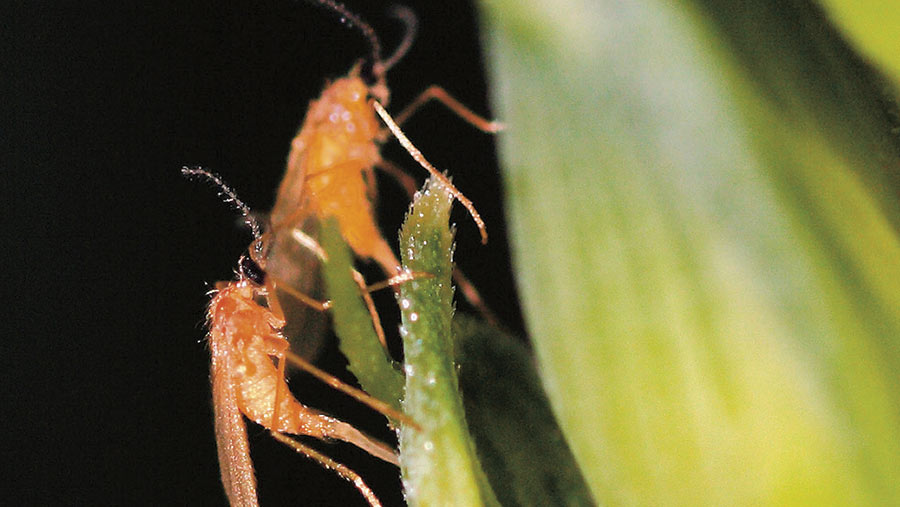
Orange wheat blossom midges © Blackthorn Arable
Orange wheat blossom midge
Feeds on the developing grain ear.
Danger time: Pre-flowering crops of wheat
Highest-risk crops: Winter wheat before ear flowering. Once flowering occurs the larvae don’t tend to survive. Milling wheat should be prioritised for treatment, as it will be the highest value.
Detection method: Commercially available pheromone traps or sticky traps that attract adult male midges only, or sticky traps that will also catch other insects that are not of value. Two traps per field at ear height. Monitor daily where possible.
Visual inspection of ears mid-evening is recommended following catches of midges in traps.
At a rate of 30 midges a trap a day in pheromone traps, crops will be at risk the following days. At a rate of 10 midges a trap in the sticky trap, visual crop inspection should begin immediately.
Treatment threshold: 120 insects a trap a day in the pheromone trap when wheat is between growth stage 45-61.
For visual inspections, a threshold of one adult midge per three ears in feed wheat, or one adult midge per six ears in milling wheat, or a cloud of midges when parting the crop.
Treatment: Timing is key as there is no remaining chemistry with a persistent action. Pyrethroids offer direct contact control for up to seven days in a best-case scenario, depending on the weather. Thiacloprid products also available.

